When Kameel Srouji remembers his mother’s cooking, his mind travels back in time, to the garden she kept outside their home in Nazareth, Israel.
As he tells me this, he stirs eggplant and tomatoes, all the while keeping an eye on customers queuing up for the fresh, vibrant, Mediterranean-style cooking that has made his "Aviva by Kameel" restaurants so popular with Atlantans.
“This is the recipe from my mama,” he says. “When I was a little boy, believe it or not, my mom grew her eggplant — and jalapenos and mint and parsley and lemons and apples. She would make jam with the apples.”
Faik Usman, the chef-owner of Cafe Raik in Duluth, remembers his family raising tomatoes, cucumbers, zucchini, okra, peppers, and herbs at their home in Galilee. His grandmother was a wedding caterer, famous for her stuffed cabbage and zucchini, her fried eggplant, and fried cauliflower. Usman soaked up his love of delicious veggies from her.
From Tel Aviv to Atlanta, I’ve yet to encounter an Israeli chef who didn’t have an affinity for farm-fresh produce: tomatoes and cucumbers, cauliflower and cabbage, pomegranates, and figs.
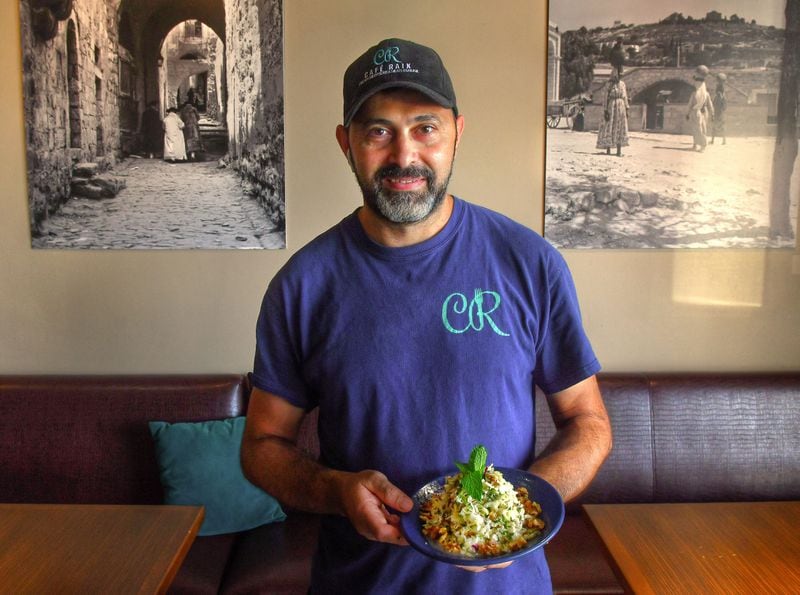
Credit: Chris Hunt
Hummus and falafel are everything to me, and I can never turn down a kebab of ground lamb or beef, seasoned with herbs and spices, nor a fresh-caught Mediterranean fish grilled on fire and seasoned with little more than salt and lemon. But the most astonishing discovery I made in Israel may have been the veggies.
As it turned out, my journey coincided with Rosh Hashana, the Jewish new year, when most businesses, including restaurants, close shop for two days. Thank goodness for the complimentary holiday apple cake at my Tel Aviv hotel, and the neighborhood convenience store, where I stocked up on chips and snacks.
And, then, on the night I was to fly home, I wandered into Santa Katarina, a stylish restaurant situated in the Great Synagogue’s courtyard, just as the sun was going down to end the holiday.
What caught my eye on the menu? A platter of grilled vegetables: green beans, okra, cauliflower, onions, tomatoes and sweet potatoes, well charred, sweet-tasting, simple yet otherworldly. Once back home, I couldn’t stop thinking about the remarkable food and agriculture of Israel.
After Shay Lavi took over Nur Kitchen on Buford Highway this year, I began to notice his seductive Instagram posts of vegetables coming from the restaurant’s scorching-hot brick oven.
“I want to be able to sustain my restaurant upon farmers entirely,” the Israel native told me in June, “and actually make a relationship that will be so good that they can grow stuff for us, and collaborate with us.” Since then, Lavi has been making good on his vision, working with Atlanta Harvest and Local Lands farms to supply him with just-picked pattypans and zucchinis, cucumbers and tomatoes, “all sorts of herbs,” plus berries, peaches, figs and watermelons.
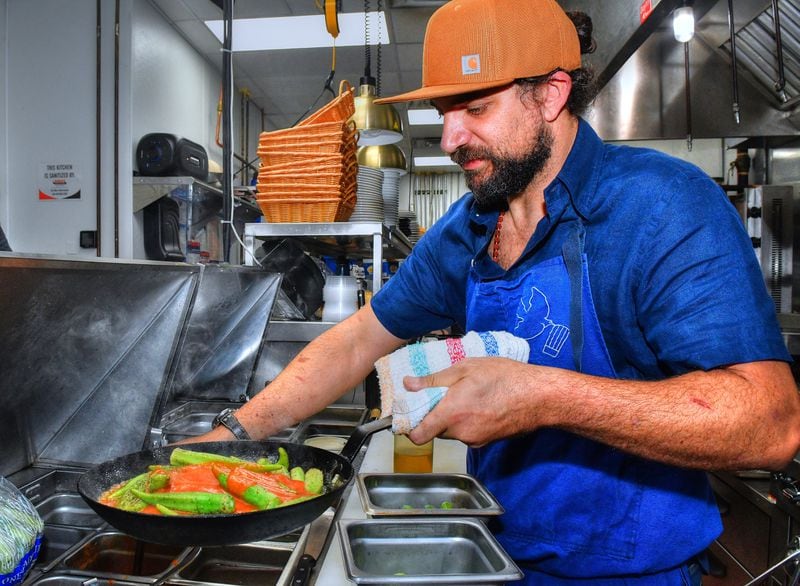
When I stopped by Nur on a recent Sunday so Lavi could share some recipes for this story, he cooked okra in a sauce made with cherry tomatoes and made a bulgur pilaf with local purple hulls.
It was then that I had an a-ha moment. Though Lavi’s creations were made with Mediterranean flair, they reminded me of the vegetables I grew up eating all summer on my family’s South Georgia farm. We had more tomatoes, okra and field peas than we knew what to do with.
No wonder I feel such a powerful connection with the small-farm culture of Israel, and with vegetable dishes prepared by Israeli-born chefs in the city I call home.
RECIPES: Vegetables with an Israeli twist
With one small exception, these Israeli-inspired vegetable recipes by Atlanta-area chefs are vegan. (To make the bulgur pilaf vegan, omit the butter.) A couple of the recipes call for vegetable stock. For such a stock, Atlanta chef Kameel Srouji suggests chickpeas: Boil 2 cups of dried chickpeas in 3 quarts to 1 gallon of water at the lowest possible heat for five hours. (Be sure to watch the pot and replenish with water if necessary.) Strain broth and save chickpeas for another use, such as hummus. Chickpea broth may be substituted for veggie stock in Shay Lavi’s Roasted Okra and Pilaf of Bulgur and Peas.
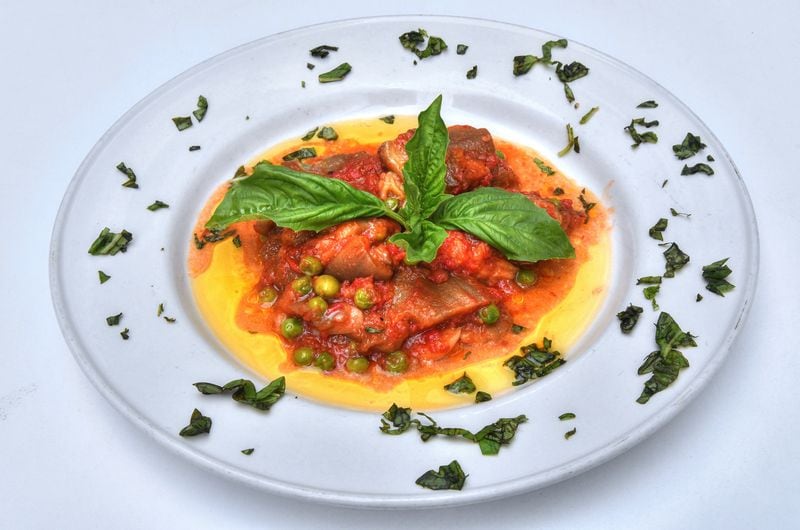
Eggplant, Huda Style
Kameel Srouji, chef-owner of Aviva by Kameel, grew up in Nazareth and attributes this recipe to his Lebanese mother, Huda. The longer you cook this simple vegan stew of eggplant, tomatoes, garlic, and basil, the better it tastes.
- 1/4 cup olive oil, plus more for drizzling
- 5 cloves garlic, sliced very thin
- 3 medium eggplants, peeled and sliced into 1-inch chunks (make sure to choose firm eggplants)
- 1/2 cup vegetable stock (may use water or Srouji’s chickpea broth, see note in intro)
- 4 medium to large ripe tomatoes, peeled and pureed
- 1 cup English peas
- 1/4 cup fresh basil, roughly chopped or torn
- Heat 1/4 cup olive oil in a large, roomy skillet over medium-high heat. When the oil glistens, toss in garlic and stir; cook for about 1-3 minutes. Add eggplant and toss to coat with oil. Stir in vegetable stock, turn heat down to medium, cover, and cook about 12 minutes, until the eggplant has softened. Add pureed tomatoes, bring to a simmer, cover, turn heat to low, and stew for about 15 minutes, or until the eggplant is quite soft. Add English peas and cook another 5 minutes. When ready to serve, add basil, and drizzle with olive oil. Serves 6.
Nutritional information
Per serving: Per serving: 192 calories (percent of calories from fat, 53), 4 grams protein, 21 grams carbohydrates, 10 grams fiber, 12 grams total fat (2 grams saturated), no cholesterol, 68 milligrams sodium.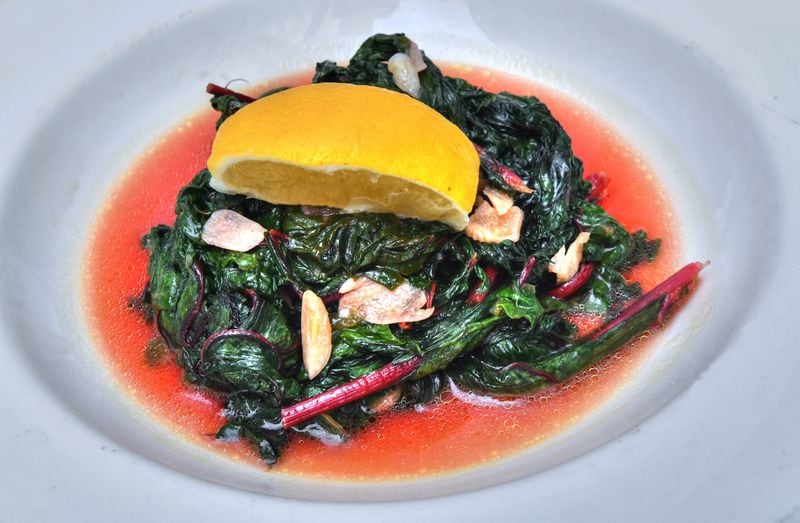
Chef Kameel’s Sauteed Chard
Chard, unlike collards or kale, is naturally tender, and thus cooks quickly, like spinach. Israeli-born chef Kameel Srouji sautes the greens quickly with nothing more than garlic, olive oil and jalapeno; finishes it with a squeeze of lemon; and serves it with rice. The colorful stems and veins of Swiss and rainbow chard will release a delicately colored, pinkish broth.
Chef Kameel’s Sauteed Chard
- 1/4 cup olive oil
- 5 cloves garlic, thinly sliced
- 1 teaspoon fresh jalapeno, finely chopped
- 2 bundles Swiss or rainbow chard, washed, stemmed and torn into pieces
- 1/2 lemon
- Heat olive oil over medium-high heat in a stockpot or lidded skillet. When oil starts to glisten, toss in garlic and jalapeno. Cook for about 2-3 minutes. Toss in chard. If the pan becomes crowded, add chard in batches, stirring often. Cover and cook over medium heat, until the greens are fully wilted and tender, about 5-8 minutes. Place in serving dish, and squeeze with lemon. Serves 2-4.
Nutritional information
Per serving: Per serving, based on 2: 263 calories (percent of calories from fat, 89), 2 grams protein, 6 grams carbohydrates, 1 gram fiber, 27 grams total fat (no saturated fat), no cholesterol, 104 milligrams sodium.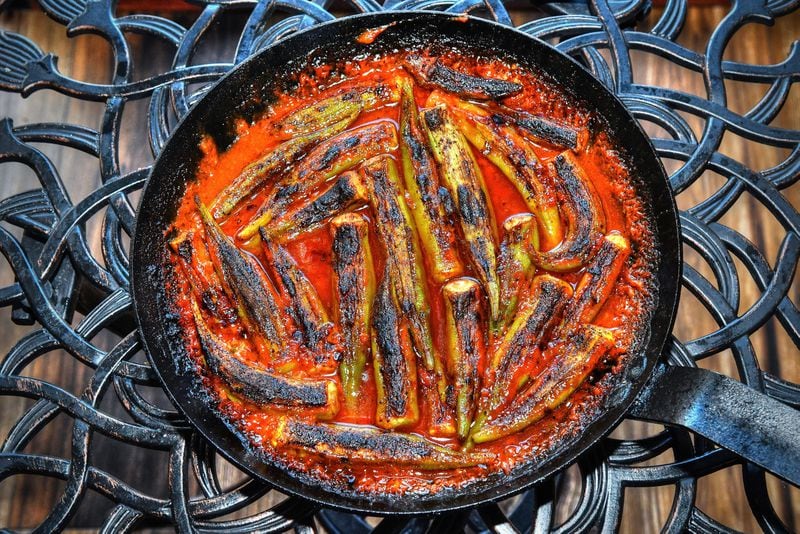
Shay Lavi’s Roasted Okra
At Nur Kitchen on Buford Highway, chef Shay Lavi loves to saute fresh whole pods of okra in tomato sauce, then place the skillet in the restaurant’s super-hot brick oven. You can get a similar effect at home by placing the okra under the broiler until it chars. Lavi pairs the okra with a pilaf of bulgur and Southern field peas.
Shay Lavi’s Roasted Okra
- For the tomato sauce:
- 2 tablespoons olive oil
- 10 cloves garlic
- 1 whole chile pepper
- 1 pound cherry tomatoes
- Sprinkle of sea salt
- For the okra:
- 2 tablespoons olive oil
- 1 tablespoon chopped onion
- 2 cloves garlic, finely minced
- 4 ounces vegetable stock (or water or chickpea broth, see note in intro)
- 1 pound fresh okra
- To make the sauce: Heat olive oil in a large stockpot with a lid over high heat. Toss in garlic and chile pepper; stir and cook for 2-3 minutes. Add cherry tomatoes, cover and cook for 6 minutes without touching the pot. (Don’t shake or stir!)
- After 6 minutes, stir and cook for 3 minutes. Rest for 20 minutes covered. Pass through a chamois or fine-mesh strainer over a bowl, reserving tomato sauce. (You should have about 8-9 ounces.) Stir in a sprinkle of sea salt. Discard solids.
- To make the okra: In a large cast-iron skillet, heat olive oil over medium-high heat. Add onion and saute until tender, about 3 minutes. Stir in garlic and cook for 1 minute. Add vegetable stock and reserved tomato sauce, and mix well. Add okra and cook until just tender, about 8-10 minutes.
- Place skillet under the broiler at high heat, and roast until the okra is charred on top, about 12-15 minutes, checking regularly so you don’t burn the okra. Makes 4 smallish portions.
Nutritional information
Per serving: Per portion: 207 calories (percent of calories from fat, 57), 4 grams protein, 20 grams carbohydrates, 6 grams fiber, 14 grams total fat (2 grams saturated), no cholesterol, 131 milligrams sodium.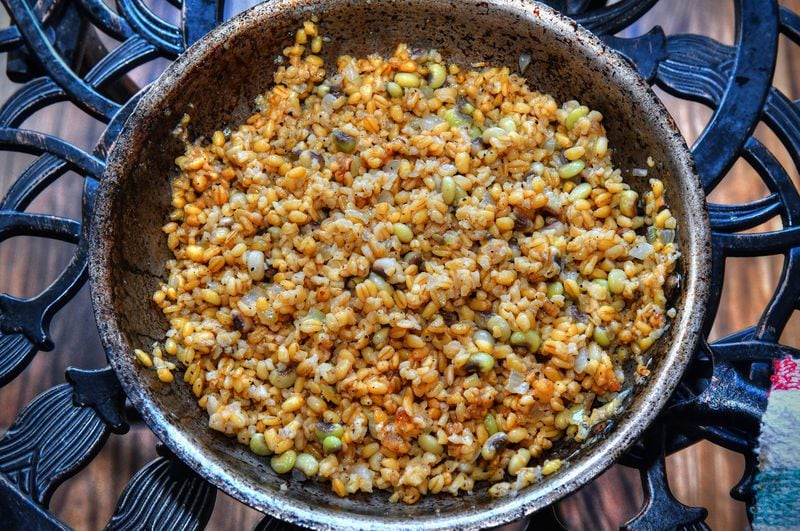
Pilaf of Bulgur and Peas
Any kind of pea or bean will work here. Favas and chickpeas are classic. Chef Shay Lavi has taken a shine to Southern field peas and made this recipe with purple hulls.
Pilaf of Bulgur and Peas
- 1 tablespoon olive oil
- 1 1/2 tablespoons finely chopped white onion
- 1 teaspoon finely minced garlic
- 1/3 cup shelled and cooked peas or beans
- 4 cups cooked coarse bulgur
- 1/2 cup vegetable stock (may use chickpea broth, see intro)
- 1 tablespoon butter (optional)
- Place olive oil in a medium saute pan or skillet over medium-high heat. Heat until oil glistens; add onion and saute for about 3-5 minutes. Stir in garlic and cook for 1 minute. Stir in peas, cooked bulgur and stock. Bring to a simmer, and turn heat down to low. Cook until most of the liquid is absorbed, about 5 minutes. Stir in butter if using. Take off heat. Rest covered for about 5 minutes. Fluff with fork when ready to serve. Serves 4.
Nutritional information
Per serving: Per serving, without butter: 157 calories (percent of calories from fat, 20), 5 grams protein, 28 grams carbohydrates, 7 grams fiber, 4 grams total fat (1 gram saturated), no cholesterol, 89 milligrams sodium.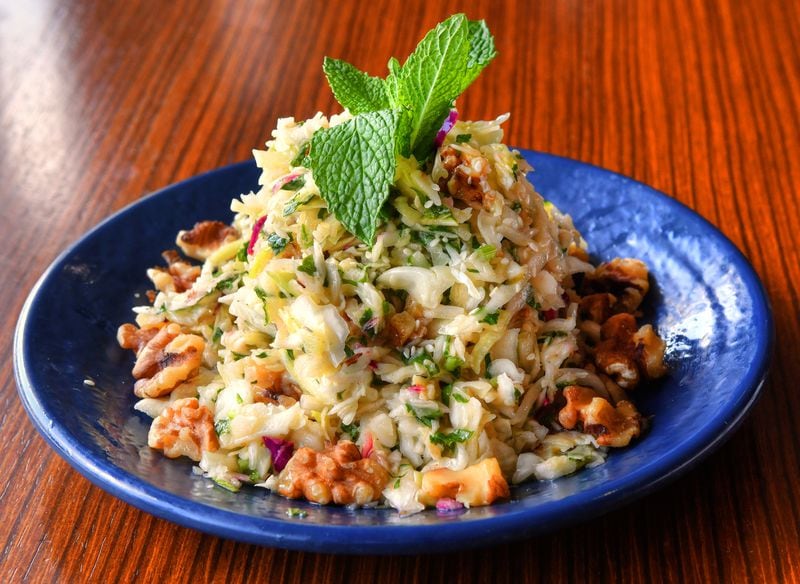
Chef Faik Usman’s Salad of Cabbage, Mint and Walnuts
This recipe — from the chef-owner of Cafe Raik in Duluth — is simple but packs big flavor. It’s a delicious way to use fall cabbage and goes with almost anything.
Chef Faik Usman’s Salad of Cabbage, Mint and Walnuts
- 1/2 small cabbage, shredded
- 1 (firmly packed) cup of fresh mint, chopped fine
- 5 cloves garlic, finely minced
- 1 teaspoon ground cumin (optional)
- 1 teaspoon salt
- Juice of 1 lemon
- 3 tablespoons olive oil
- 1 cup toasted walnuts, chopped
- 2 tablespoons toasted sesame seeds (optional)
- In a large mixing bowl, toss cabbage, mint and garlic. Sprinkle with cumin (if using), salt and lemon juice, and stir to combine. Add olive oil and stir again. When ready to serve, add walnuts and sesame seeds (if using). Store any leftovers, covered, in refrigerator. Serves 6.
Nutritional information
Per serving: Per serving, without toasted sesame seeds: 240 calories (percent of calories from fat, 75), 5 grams protein, 10 grams carbohydrates, 4 grams fiber, 20 grams total fat (2 grams saturated), no cholesterol, 339 milligrams sodium.